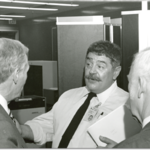George A. Michael

Pioneering computational physicist George Michael died at his home in Livermore on June 5. He was 82.
Hired as a theoretical physicist in 1953, Michael played an instrumental role in building the Laboratory’s high-performance computing program and the Lab’s international reputation as a leader in supercomputing. The legacy of his 41-year career at the Laboratory includes founding the annual Supercomputing Conference (SC) that will celebrate its 20th anniversary this November in Austin, Tex. and the Salishan Conference in Oregon begun in 1981.
In his early years at LLNL, Michael served as a liaison between physicists and the “coders” or computer programmers. “Then the lure of computation overcame me,” he recalled in a November 2006 interview. That year, organizers of SC06 recognized Michael for his work as conference founder.
What began modestly in Orlando, Fla. as a technical exchange gathering of 1,400 in 1988, the Supercomputing Conference, held in a different U.S. city each year, has grown into the premier high-performance computing (HPC) conference, attracting more than 10,000 participants annually representing the leading companies and research institutions in high-performance computing from around the world.
Bob Borchers, associate director for Computation in the 1980s, said Michael had a rare ability to galvanize the people around him to a cause or project that made him uniquely qualified to bring together the larger scientific computing community. “George’s role was always to build communities,” Borchers said. “He was a genius at bringing people together to work towards a common goal.
“George got the weapons people to talk to the computing researchers and industry people,” Borchers said, noting that Michael organized and founded one of the Lab’s first computing research organizations.
Mike McCoy, deputy associate director for Computation and head of LLNL’s Advanced Simulation and Computing (ASC) Program, said that Michael helped lay the groundwork for the tri-lab ASC effort. “George Michael’s powerful influence and the conferences he was instrumental in founding helped define what supercomputing is today,” McCoy said. “One of his most remarkable attributes was that he was so modest about his contributions. Even his family was largely unaware of his reputation in the computing world.”
Even after his retirement in 1991, Michael continued to be active in the HPC community and devoted time to compiling a history of computing at LLNL, notably documenting computing innovations that had been poorly documented or overlooked altogether. These can be found on Michael’s Website.
“One important realization that's come from George’s historical work is that much of what we now take for granted in computing was pioneered at Livermore: high quality graphics and sound, the machinery that generated them, and the software that ran on it. All got at least some part of their start at LLNL,” said Tom DeBoni, who retired after a career in UC computing facilities at Livermore and Lawrence Berkeley labs, and who helped Michael compile historical material for his Website. “Some of the early work documented on our site was ahead of its time. The lineage from then to now is readily apparent. It goes to show that one cannot easily predict how useful an idea will be nor where it will lead, and we owe a lot to the scientists and engineers at Livermore who weren't afraid to experiment.”
Born Feb. 16, 1926, in Buffalo, N.Y. where he grew up, Michael attended and received a physics degree from the University of San Francisco. While at USF he also worked as a postman. He came to work at the Laboratory after graduating and moved to Livermore where he raised his family. While the Laboratory may have been a second home, he was dedicated to his family and it wasn’t until late in his life that his family became aware of his important contributions to computing. “His focus was always family when he was at home,” said his daughter Karen.
He also is remembered for his sense of humor and love of practical jokes as evidenced in his contribution to “Fifty Years of Stories,” a book of stories the Lab published for its 50th anniversary celebration in 2002.
Michael is survived by his eight children: Karen Tootle of Livermore; Phyllis Wong of Michigan; Christine Scrivani of Oakland; Patrick Michael of Twain Harte; Michael Michael of Livermore; Theresa Guerrero of Walnut Creek; Martha Gates of Sacramento; Capt. Sarah Standard of Maryland; 18 grandchildren and three great grandchildren.
Mass is at St. Michael’s Catholic Church today (Friday, June 13) at 11 a.m., 458 Maple St., Livermore. Private interment will be at a later date. In lieu of flowers, contributions to the ACM/IEEE Computer Society High Performance Computing (HPC) Ph.D. Fellowship Program fund may be sent to: ACM, Attn: Stephen Sisler/HPC Fellowship, 2 Penn Plaza, Suite 701, New York, NY 10121-0701. Checks should be made payable to ACM.
-- Don Johnston




